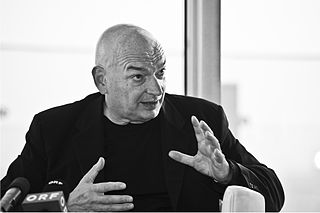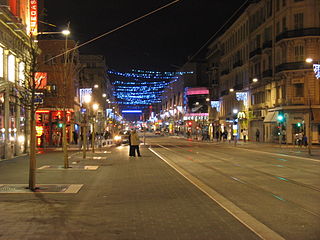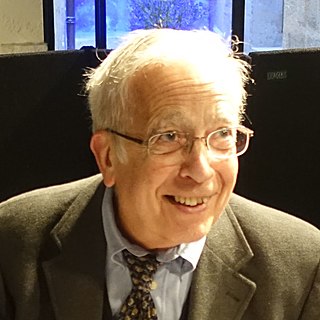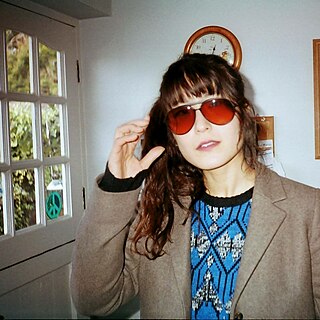
Yann Kersalé (born 17 February 1955) is a French conceptual artist who works with light. His studio is in Vincennes.

Yann Kersalé (born 17 February 1955) is a French conceptual artist who works with light. His studio is in Vincennes.
Kersalé was born in Boulogne-Billancourt, [n 1] a suburb of Paris, and spent part of his childhood in the Breton port town of Douarnenez. [1] He graduated from the École des Beaux-Arts in Quimper in 1978. [1] [2] Beginning in 1984 at the Société métallurgique in Caen, [1] he has produced architectural illuminations of both natural environments and buildings that have given rise to a school of modern French light art. [3] He has worked with Helmut Jahn on the Sony Center in Berlin and the Bangkok and Chicago O'Hare airports and with Jean Nouvel on the Lyon Opera House, the Torre Agbar in Barcelona, the Musée du quai Branly, the Philharmonie concert hall in Paris, and the Abu Dhabi branch of the Louvre Museum. He has also been commissioned to design projects for numerous cities, including Nantes, Rennes, Saint-Nazaire, Le Havre, Cherbourg, Bordeaux, and Montpellier in France and Bangkok, Quebec City, Frankfurt, Berlin, Las Vegas, Washington, DC, Lisbon, Brussels, and St Petersburg in other countries. [4] [5] In 2007 alone, he worked in Luxembourg, Paris, and Korea. [4]
He has also produced an interior lighting scheme for the Francilien commuter trains, [6] [7] and in 2010 the Jallum lighting units for Baccarat, rechargeable and dimmable LED lights in cut crystal cylinders on anodised aluminium bases for indoor or outdoor use. [8] [9] [10]
Kersalé rejects the label of either architect or light artist, preferring that of "project artist". [11] He has chosen the night, "the locus of choice of what is perceived", to create "luminous fictions, a narrative work on the spirit and memory of cities." However, he "fights ceaselessly against artificial lighting that kills authentic nocturnality and masks the sky", which has led him to create innovative new forms of illumination. [12] In 2011, a reviewer in Le Figaro called him "a passionate fan of chiaroscuro" who loves to plunge viewers into an "abyss" of total darkness to maximise their perception of the surprising narrative fantasies he constructs with light. [13]
He regards his work for cities as a form of urban renewal, reclaiming areas where people can stroll safely at night, and saving industrial artifacts that might otherwise be destroyed. [5] For example, his lighting of the boat lifts at Thieu, Belgium, led to their preservation and the creation of a tourist promenade, [14] and his project at the submarine base in Saint-Nazaire transformed a liability that was to have been demolished into a civic asset. [15] The base is now a cultural centre with shops and a museum, and Barcelona architect Manuel de Solà-Morales redesigned the surrounding area. [16]



Provence-Alpes-Côte d'Azur, also known as Région Sud, is one of the eighteen administrative regions of France, located at the far southeastern point of the mainland. The main prefecture and largest city is Marseille, France's second-largest urban area after Paris, with slightly less than one million residents.

Alain Tanner was a Swiss film director.

The Torre Glòries, formerly known as Torre Agbar, is a 38-story skyscraper located between Avinguda Diagonal and Carrer Badajoz, near Plaça de les Glòries Catalanes, which marks the gateway to the new technological district of Barcelona, Catalonia, Spain. It was designed by French architect Jean Nouvel in association with the Spanish firm b720 Fermín Vázquez Arquitectos and built by Dragados. The Torre Glòries is located in the Poblenou neighbourhood of Barcelona and it was originally named after its owners, the Agbar Group, a holding company whose interests include the Barcelona water company Aigües de Barcelona.

The Nice tram is a 27.5-kilometre (17.1 mi), triple-line tram in the city of Nice in Provence-Alpes-Côte d'Azur, France. It is operated by the Société nouvelle des transports de l'agglomération niçoise division of Transdev under the name Lignes d'azur.
The École supérieure de réalisation audiovisuelle is a French private film school which specialises in the training of cinema, television, photography, sound engineering and digital art through the DESRA diploma, the DESTS and the DESFA.
Edmond Couchot was a French digital artist and art theoretician who taught at the University Paris VIII.

Raymond Depardon is a French photographer, photojournalist and documentary filmmaker.

Jean Nouvel is a French architect. Nouvel studied at the École des Beaux-Arts in Paris and was a founding member of Mars 1976 and Syndicat de l'Architecture, France’s first labor union for architects. He has obtained a number of prestigious distinctions over the course of his career, including the Aga Khan Award for Architecture, the Wolf Prize in Arts in 2005 and the Pritzker Prize in 2008. A number of museums and architectural centres have presented retrospectives of his work.

Richard Conte is a contemporary artist and art professor.

Architecture of the night or nocturnal architecture, also referred to as illuminated architecture and, particularly in German, light architecture, is architecture designed to maximize the effect of night lighting, which may include lights from within the building, lights on the facade or outlining elements of it, illuminated advertising, and floodlighting.

The Avenue Jean Médecin is a street located in the center of Nice, one of the city's main north-south traffic arteries. In Niçard, it is officially named the "avenguda Jouan-Medecin, consòu de Nissa". It constitutes the city's main shopping street and is called "The Avenue" by residents.

Pointe de la Torche is a promontory located at the southeastern end of the Baie d'Audierne in the commune of Plomeur in the Bigouden region of Finistère, France. It is an officially recognised natural site and at the top of the promontory is a prehistoric settlement and burial site that is registered as a historic monument.
Tatiana Fabeck is a Luxembourger architect who since 1996 has run her own business in Koerich, Luxembourg.

Yann Toma born in 1969 in is both an artist and a researcher, the lifelong president of the company Ouest-Lumière and an artist-observer within the UN, where he sits as an entrepreneurial artist. With projects always anchored in a societal context, Yann Toma's fundamental idea is to rebuild the link. Connecting with ourselves, our collective memory, and the transforming power generated by the mass, art is used here as a means of materializing energy flows but also as an energy in its own right.

Sara Holt is an American sculptor and photographer. She is creating mainly in sculpture and photography and more recently in ceramics. She is one of the contemporary artists whose work helps to refine the field of creation situated within the boundaries of science and art.

Yann Le Bohec is a French historian and epigraphist, specializing in ancient Rome, in particular North Africa during Antiquity and military history.
Jean Daviot is a French contemporary artist born in Digne. He went to the art school at the Villa Arson in Nice and lives and works in Paris.
Marcella Lista is a French curator and art historian. She is chief curator at the Centre Pompidou.
Martine Aballéa is a French-American artist born in 1950.

Makiko Furuichi is a visual artist and French Painter.